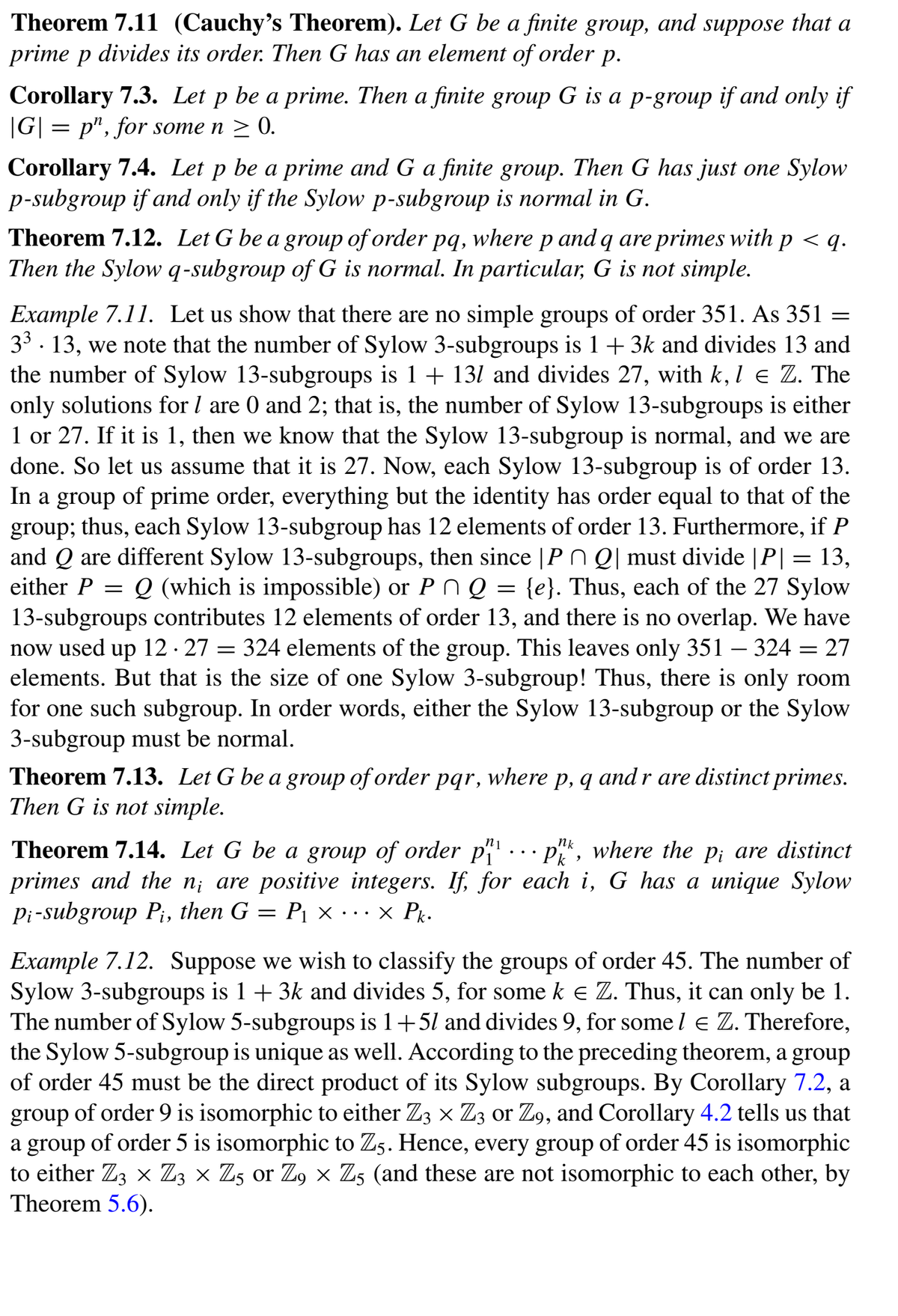7.30. Show that there are no simple groups of order 56.
Elements Of Modern Algebra
8th Edition
ISBN:9781285463230
Author:Gilbert, Linda, Jimmie
Publisher:Gilbert, Linda, Jimmie
Chapter4: More On Groups
Section4.8: Some Results On Finite Abelian Groups (optional)
Problem 6E: 6. For each of the following values of , describe all the abelian groups of order , up to...
Related questions
Question
100%
Could you explain how to show 7.30 in detail? I also included lists of definitions and theorems in the book as a reference.

Transcribed Image Text:Theorem 7.11 (Cauchy's Theorem). Let G be a finite group, and suppose that a
prime p divides its order. Then G has an element of order p.
Corollary 7.3. Let p be a prime. Then a finite group G is a p-group if and only if
|G| = p", for some n > 0.
Corollary 7.4. Let p be a prime and G a finite group. Then G has just one Sylow
p-subgroup if and only if the Sylow p-subgroup is normal in G.
Theorem 7.12. Let G be a group of order pq, where p and q are primes with p < q.
Then the Sylow q-subgroup of G is normal. In particular, G is not simple.
Example 7.11. Let us show that there are no simple groups of order 351. As 351 =
33. 13, we note that the number of Sylow 3-subgroups is 1 + 3k and divides 13 and
the number of Sylow 13-subgroups is 1+ 131 and divides 27, with k, l e Z. The
only solutions for l are 0 and 2; that is, the number of Sylow 13-subgroups is either
1 or 27. If it is 1, then we know that the Sylow 13-subgroup is normal, and we are
done. So let us assume that it is 27. Now, each Sylow 13-subgroup is of order 13.
In a group of prime order, everything but the identity has order equal to that of the
group; thus, each Sylow 13-subgroup has 12 elements of order 13. Furthermore, if P
and Q are different Sylow 13-subgroups, then since |P N Q| must divide |P| = 13,
either P = Q (which is impossible) or P n Q = {e}. Thus, each of the 27 Sylow
13-subgroups contributes 12 elements of order 13, and there is no overlap. We have
now used up 12 · 27 = 324 elements of the group. This leaves only 351 – 324 = 27
elements. But that is the size of one Sylow 3-subgroup! Thus, there is only room
for one such subgroup. In order words, either the Sylow 13-subgroup or the Sylow
3-subgroup must be normal.
-
Theorem 7.13. Let G be a group of order pqr, where p, q and r are distinct primes.
Then G is not simple.
Theorem 7.14. Let G be a group of order p... p"*, where the p; are distinct
primes and the n¡ are positive integers. If, for each i, G has a unique Sylow
Pi-subgroup P;, then G = P¡ x ..× Pk.
Example 7.12. Suppose we wish to classify the groups of order 45. The number of
Sylow 3-subgroups is 1+ 3k and divides 5, for some k e Z. Thus, it can only be 1.
The number of Sylow 5-subgroups is 1+51 and divides 9, for some l e Z. Therefore,
the Sylow 5-subgroup is unique as well. According to the preceding theorem, a group
of order 45 must be the direct product of its Sylow subgroups. By Corollary 7.2, a
of order 9 is isomorphic to either Z3 x Z3 or Z,, and Corollary 4.2 tells us that
a group of order 5 is isomorphic to Z5. Hence, every group of order 45 is isomorphic
to either Z3 x Z3 × Z5 or Z9 × Z5 (and these are not isomorphic to each other, by
Theorem 5.6).
group

Transcribed Image Text:7.30. Show that there are no simple groups of order 56.
2·3·5· 29. Show that at least one of the
7.32. Let G be a group of order 870
Sylow p-subgroups of G must be normal, for some prime p dividing |G|.
Expert Solution
This question has been solved!
Explore an expertly crafted, step-by-step solution for a thorough understanding of key concepts.
This is a popular solution!
Trending now
This is a popular solution!
Step by step
Solved in 2 steps with 2 images

Knowledge Booster
Learn more about
Need a deep-dive on the concept behind this application? Look no further. Learn more about this topic, advanced-math and related others by exploring similar questions and additional content below.Recommended textbooks for you

Elements Of Modern Algebra
Algebra
ISBN:
9781285463230
Author:
Gilbert, Linda, Jimmie
Publisher:
Cengage Learning,

Elements Of Modern Algebra
Algebra
ISBN:
9781285463230
Author:
Gilbert, Linda, Jimmie
Publisher:
Cengage Learning,